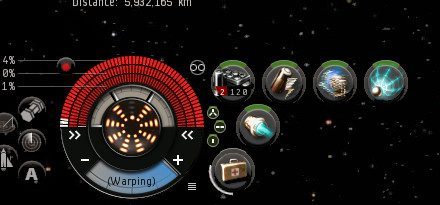In part three of my Eve Online Wormhole Guide, I alluded to many of the potential cosmic anomalies available to those daring to explore w-space. In this fourth and final installment, I focus on the idea of risk versus reward, and how to maximize the opportunities presented by these uncharted reaches.
Exploring or even living inside a wormhole system provides a unique chance to accumulate great wealth, but a potent truism is to consider anything you fly into a wormhole to be already lost. There are many dangers in the unexplored reaches, both from NPC Sleepers to enemy corporations and gank fleets, far more dangerous than in regular space. Whether the stress and bounty of w-space is worthwhile is a question only you can answer for yourself.
Sleeper Loot and Salvage
Unlike empire space NPCs, killing Sleepers does not provide bounty bonuses or module drops. Instead each wreck contains “Blue Loot” which is sold to NPC buy orders in high-security space – it has no value otherwise. These buy orders can be very valuable, worth between 50,000 and 5,000,000 ISK apiece.
The loot obtained by Salvaging Sleeper wrecks is used by players in all areas of New Eden for Tech 3 Production. Battleship wrecks may require a Salvaging skill rating of four or higher. If you find a Melted Nanoribbon after salvaging make sure to get it to market as quickly as possible for a huge return.
Strategic Cruisers
Tech 3 Strategic Cruisers are the bread and butter of w-space systems. With high resistances, the ability to be customized to a variety of configurations, and the unique advantage of equipping an interdiction nullifier if desired, these ships amazingly still fit in a package the size of a cruiser.
While the benefits of flying a Strategic Cruiser are many, they are ideal targets for ganking fleets and the cost for the hull alone can be over 100 million ISK, with the total fitting reaching well over 400 million ISK just to undock. Losing one of these ships to Sleepers or hostile players is a very expensive lesson not many pilots can afford to learn.
Ganking
Because there is no Local population list like in the rest of New Eden, w-space pilots are always at great risk of being attacked without warning. The terms of an engagement are almost always set by the aggressing party, and thus it’s not a pitched battle but an assassination gank. Players are ganked for fun, profit, or control of a wormhole system itself. Despite the seemingly empty vastness of w-space, a happenstance connecting wormhole can link a system to a highly active, aggressive, motivated wormhole corporation.
Realistically there’s little that can be done to prevent getting ganked, other than continually rescanning the area for new arrivals, particularly scanning probes, and flying to a reasonably safe location at the earliest hint of ingress. Rather than avoidance, many pilots advocate a mitigation strategy, flying the barest modules and ships required to tackle the desired site, so if they lose their ship they aren’t out billions of ISK.
While many see wormhhole exploration as a PVE endeavor, it is almost impossible to avoid PVP – if you fly a faction ship with deadspace mods for racing through level four missions, keep it docked and as far away from w-space as possible. If you deal with wormhole exploration long enough, you will be ganked, but many find the risk very worth the reward.
Planetary Interaction
Some of the most material-rich planets in EVE Online are contained within wormhole space, which yield a fantastic and reliable opportunity for those looking to produce goods or fuel their own stations, also a necessity for those looking to make a permanent home in these untamed lands.
The downside of having a planetary installation in w-space is that it’s in w-space. Not only could you be forced out of the area by a rival fleet or corporation, making your precious minerals inaccessible, regularly warping to and from the Customs Office gives hostile scouts a regular schedule in which to find and destroy you.
Tactics for Staying “Safe” in W-Space
1. Directional Scanning
The D-Scan is often the best source of intelligence regarding what else is in the system with you. When jumping into a w-space system, you should always check your d-scan while holding your gate cloak, after bookmarking the wormhole’s location. No matter how recently you were in the same system, no matter if you have a friend already inside, check your d-scan. Circumstances can change very quickly inside wormholes and every second of warning will help.
By changing the range and narrowing the angle of your d-scan, as well as pointing your camera or solar system view at different objects, you may be able to get a better idea of what is lying in wait in a particular direction, particularly at scannable sites like Signatures or Anomalies.
Experienced pilots may use specific overview filters to help narrow down their scan results, developing over time an idea of what items are superfluous and which are important.
2. Ship Naming Conventions
Some w-space corporations have their own specific ship naming conventions which help all active pilots determine if an unexpected d-scan result is a friendly or not. It is important to change your naming convention regularly however, as patient enemies may adopt one they witness and charge into your pilots.
This practice is also recommended if you are flying a fleet into w-space to help distinguish friend from foe at first glance.
3. Bookmarking
Unless you want to go directly to a cosmic anomaly or celestial object, you will always need a bookmark to go somewhere when you’re inside a wormhole. Every time you warp somewhere new you must bookmark it if you want to return without repeating the work you did to find it in the first place, since there are no ready waypoints or guide markers in this space.
Make good use of the corporate bookmark system, particularly if your corporation is hoping to live out of a particular w-space pocket, which reduces the number of bookmarks any one pilot has to make. Learn to make safe-spot bookmarks for yourself far away from any celestial object and change or update them regularly.
Always, always, always bookmark both sides of a wormhole to make sure you can find your way back out without probing. Don’t be caught in a w-space pocket without a clear idea of how to leave!
4. System Occupancy and POS Intel
One way to figure out who is active inside a wormhole is to check the ownership of the system’s Player-Owned Customs Offices, if available. With the ownership information you can use an updated killboard website to learn their fleet compositions and what systems they are most active in, and even during what time zones.
5. Cloaking
This should go without saying, but once a person is cloaked there is no way to detect them. Unless you get to close to another object you are safe so long as your cloak module holds out. There are ways locals can attempt to decloak interlopers such as anchoring jet cans around their POSes or setting up drag bubbles, but ideally you can see them on your d-scan.
If you have a cloak, keep it up as much as possible – there is absolutely nothing to gain by being visible, and safety comes with being invisible. Even when sitting inside a POS shield, if you’re able to cloak up, do so; prevent the enemy from gaining any potential information about you.
6. Anomalies vs. Signatures
Although everything has to be scanned down before it can be warped to, not everything needs probes to be found. While in a cosmic signature you have a reasonable expectation that there will be probes in space before any hostiles arrive, though good scanners can have your location zeroed in under fifteen seconds.
Additionally hostiles may have previously visited this wormhole and bookmarked all sites, in which case they would fly from site to site in search of you, completely undetected.
For anomalies hostiles can enter through a wormhole sitting outside of d-scan range, warp to a nearby planet, warp in at range, and position themselves next to you with no way for you to see them coming. The only way to detect this intrusion is to be constantly probing for new signatures and to remember that every ship can find your site when you’re in an anomaly.
7. Site-Running Best Practices
Other players aren’t the only danger facing you in wormhole space. Even a small wave of Sleepers can tear apart inexperienced or unprepared pilots. There are general guidelines to follow when running sites, particularly useful as the system class gets larger. These recommendations don’t require the pilots to have maximized skills, but it’s far better to be overskilled than floating in a pod.
- Class 1 Wormhole: A solo battlecruiser can probably handle the Sleepers
- Class 2: A small battlecruiser gang is appropriate
- Class 3: A medium-sized battlecruiser gang or a small remote-repair battleship gang should be used
- Class 4: A medium-sized remote-repair battleship gang at the least
- Class 5: Bring a large remote-repair battleship gang
- Class 6: You already know what you’re doing, so do that
This concludes my EVE Online wormhole guide, compiled in 2016 for some old corp-mates. I genuinely hope you find the information useful, and that following these tips will help you make a profitable and healthy life inside w-space. For easy digest I have also made a single-document guide available for download, though I always appreciate credit and a link back to this website if you decide to share it!
While I liked the format of breaking up the document into multiple posts, I think in future I’ll be posting my guides in fewer, but more content-rich, chunks, to make sure I’m able to get the content out to players in both a reasonable time-frame and with a minimum of clicking, without overloading people all at once.
I’m very proud of the work I did to put all of these guides together, and I hope players of Eve Online find them useful!
Fly safe out there.
Header image taken from promotional material for EVE Online, copyright CCP Games.














